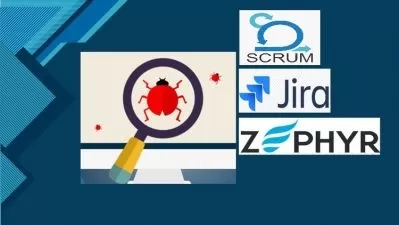Scrum Master PSM II Certification Prep - Agile 2022 (PSM 2)
Michael James,Learn Management Online
4:13:02
Description
Prepare to take the PSM II certification in Agile Scrum. Learn how to deal with challenging senarios as a Scrum Master
What You'll Learn?
- Preperation and advice for taking the Professional Scrum Master 2 (PSM 2) certification
- Advance your Scrum knowledge to the next level with a detailed look at the more difficult Scrum concepts
- A close look at many challenging senarios and how to deal with them correctly using Scrum
- A deep dive on the types of questions and topics you may get asked in the PSM 2 assesment
- About the Professional Scrum Master PSM 2 certification with all the preparation necessary to take the assessment
- Tried and tested advice on applying the Scrum theory in practice
- All Scrum theory covering the Scrum Team, Scrum Events, Scrum Artifacts, Empiricism and Evidence-based Management
- Questions, answers and detailed explantions on the answers
Who is this for?
More details
DescriptionBoost your CV with an advanced Scrum Master qualification the Professional Scrum Master II certification (PSMÂ II).
Learn how to use Scrum effectively to handle the most challenging scenarios.
Many people take PSM I, but you can become one of the few with the more advanced PSM II!
Do you want to take your Scrum knowledge to the next level?
Great, then this course is for you!
This course will present you with difficult example situations and teach you how to handle them using Scrum to find the best solutions. It will help you become a more effective Scrum Master that can lead a team to become effective and professional, utilising professional Scrum.
Knowing Scrum is common, but knowing how to use Scrum in some of the most challenging management scenarios is a real advantage.
This course will present you with difficult example situations and teach you how to handle them using Scrum to find the best solutions. It will help you become a more effective Scrum Master that can lead a team to become effective and professional, utilising professional Scrum.
If you are an entrepreneur with an idea, this course will teach you how to make a team self-manage, and turn your vision into a reality ready for the marketplace, backed by real-world feedback and reduced risk.
After taking this course, you will have a good understanding of the skills necessary for effective leadership as a Scrum Master and be well prepared to take the PSM II Scrum Master certification.
Until now, you might have struggled to manage a team to build the right product or solution...
Or, you might have finished a project and the item developed was over budget, delayed and once launched it didn't get as many users as you hoped.
If this sounds familiar, then this course will help!
Who is your instructor?
Michael James is a UK Business and Leadership Instructor who has over a decade of experience in management and leadership in the corporate environment and has been working in product development for over 10 years as both a private consultant and for one of the largest organizations in the UK. Michael James has also managed and built many private entrepreneurial mobile app and website products with 1000s of downloads and users.
This course covers the entire Scrum theory essentials focusing on the Product Owner. It also includes software practicals and advice from tried and tested experience:
This course covers the entire Scrum theory essentials focusing on the Scrum Master. It also includes example scenario questions and explanations on the following:
Agile and Scrum are explained in a greater depth than PSM 1
The PSM II certification exam preparation
Practice questions with detailed explanations
Questions inspired by the PSM II certification exam
Certification assessment tips
Example problem scenarios and how to handle them
How to apply Scrum in challenging situations
Developing people and teams
How to handle problematic team members
How to handle difficult stakeholders
Scrum Master coaching and leadership
Organizational culture and Scrum adoption
Finding solutions to differeing opinions and conflict
Dealing with Technical Debt
Coaching in the Scrum Values
How to handle dependencies
Scaled Scrum
Nexus Scrum
Scrum Theory
Scrum Values
Empiricism
Evidence-based management
Professional vs mechanical Scrum
The Product Owner role
The Scrum Master role
The Developer role
The Scrum Events
The Scrum Artifacts
The Scrum Guide
The Sprint
Sprint Planning
Sprint Review
Sprint Retrospective
Common problems and solutions
...and much more!
Anyone who is looking to build a career in Scrum, Agile and management must understand the above. If you don't, then this course is perfect for you.
So go ahead and click the enrol button, and we'll see you in lesson 1!
Cheers,
Mike
Who this course is for:
- People wanting to take Professional Scrum Master PSM 2 certification
- Anyone wanting to stand out on their CV with a more advanced Scrum qualification
- People who want a more indepth guide on how to apply Scrum in challenging situations
- People wanting to progress their career in management and product development
- Project Managers looking to reskill with the Scrum Framework
- Entrepreneurs looking to get the most value out of their Developers and developed products
- Anyone interested in Agile or Scrum
- Developers looking for a side ways move into Scrum Management
- Anyone looking obtain a certification in Scrum as a Scrum Master
Boost your CV with an advanced Scrum Master qualification the Professional Scrum Master II certification (PSMÂ II).
Learn how to use Scrum effectively to handle the most challenging scenarios.
Many people take PSM I, but you can become one of the few with the more advanced PSM II!
Do you want to take your Scrum knowledge to the next level?
Great, then this course is for you!
This course will present you with difficult example situations and teach you how to handle them using Scrum to find the best solutions. It will help you become a more effective Scrum Master that can lead a team to become effective and professional, utilising professional Scrum.
Knowing Scrum is common, but knowing how to use Scrum in some of the most challenging management scenarios is a real advantage.
This course will present you with difficult example situations and teach you how to handle them using Scrum to find the best solutions. It will help you become a more effective Scrum Master that can lead a team to become effective and professional, utilising professional Scrum.
If you are an entrepreneur with an idea, this course will teach you how to make a team self-manage, and turn your vision into a reality ready for the marketplace, backed by real-world feedback and reduced risk.
After taking this course, you will have a good understanding of the skills necessary for effective leadership as a Scrum Master and be well prepared to take the PSM II Scrum Master certification.
Until now, you might have struggled to manage a team to build the right product or solution...
Or, you might have finished a project and the item developed was over budget, delayed and once launched it didn't get as many users as you hoped.
If this sounds familiar, then this course will help!
Who is your instructor?
Michael James is a UK Business and Leadership Instructor who has over a decade of experience in management and leadership in the corporate environment and has been working in product development for over 10 years as both a private consultant and for one of the largest organizations in the UK. Michael James has also managed and built many private entrepreneurial mobile app and website products with 1000s of downloads and users.
This course covers the entire Scrum theory essentials focusing on the Product Owner. It also includes software practicals and advice from tried and tested experience:
This course covers the entire Scrum theory essentials focusing on the Scrum Master. It also includes example scenario questions and explanations on the following:
Agile and Scrum are explained in a greater depth than PSM 1
The PSM II certification exam preparation
Practice questions with detailed explanations
Questions inspired by the PSM II certification exam
Certification assessment tips
Example problem scenarios and how to handle them
How to apply Scrum in challenging situations
Developing people and teams
How to handle problematic team members
How to handle difficult stakeholders
Scrum Master coaching and leadership
Organizational culture and Scrum adoption
Finding solutions to differeing opinions and conflict
Dealing with Technical Debt
Coaching in the Scrum Values
How to handle dependencies
Scaled Scrum
Nexus Scrum
Scrum Theory
Scrum Values
Empiricism
Evidence-based management
Professional vs mechanical Scrum
The Product Owner role
The Scrum Master role
The Developer role
The Scrum Events
The Scrum Artifacts
The Scrum Guide
The Sprint
Sprint Planning
Sprint Review
Sprint Retrospective
Common problems and solutions
...and much more!
Anyone who is looking to build a career in Scrum, Agile and management must understand the above. If you don't, then this course is perfect for you.
So go ahead and click the enrol button, and we'll see you in lesson 1!
Cheers,
Mike
Who this course is for:
- People wanting to take Professional Scrum Master PSM 2 certification
- Anyone wanting to stand out on their CV with a more advanced Scrum qualification
- People who want a more indepth guide on how to apply Scrum in challenging situations
- People wanting to progress their career in management and product development
- Project Managers looking to reskill with the Scrum Framework
- Entrepreneurs looking to get the most value out of their Developers and developed products
- Anyone interested in Agile or Scrum
- Developers looking for a side ways move into Scrum Management
- Anyone looking obtain a certification in Scrum as a Scrum Master
User Reviews
Rating
Michael James
Instructor's CoursesLearn Management Online
Instructor's Courses
Udemy
View courses Udemy- language english
- Training sessions 150
- duration 4:13:02
- Release Date 2022/12/24
















